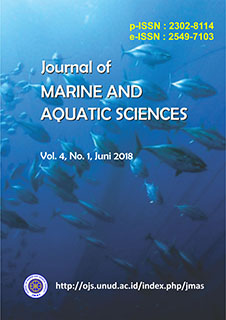Kerapatan Hutan Mangrove Berbasis Data Penginderaan Jauh di Estuari Perancak Kabupaten Jembrana-Bali
Abstract
The mangrove ecosystem is one of the objects that can be identified by using remote sensing technology. The geographical location of the mangrove ecosystem located in the land and sea transition areas provides a distinctive recording effect when compared to other land vegetation objects. Remote sensing information about vegetation density is useful for various needs such as estimation of the availability of wood fuel biomass, succession stages, forest degradation and so on. This study aims to map the mangrove density using NDVI mangrove vegetation index from Landsat 8 image in Estuari Perancak, Jembrana, Bali. The study was conducted on August 20, 2016 until August 25, 2016. The analysis used is correlation analysis and t-Test analysis. Based on the results of the study, it was found that the density class was rare, medium and tight. The density class rarely has a pixel value range from 0.4765 to 0.6128, the medium density class has a pixel value range of 0.6128 to 0.7093, and the dense or dense density has a pixel value range of 0.7093 to 0.7947. The dominant mangrove species is Rhizopora sp. The linear regression equation in the above figure shows y = 0.679x + 0.438 and with the correlation (r) of 0.9642. This means that the density of mangroves and NDVI is directly proportional. Where the higher the value of mangrove density, the higher the value of NDVI and reserve.
Downloads

This work is licensed under a Creative Commons Attribution 3.0 International License.
Copyright 2012 - 2023 Journal of Marine and Aquatic Sciences (JMAS)
Published by Fakultas Kelautan dan Perikanan Universitas Udayana, Denpasar, Bali, Indonesia
JMAS (p-ISSN 2302-8114; e-ISSN 2549-7103)


